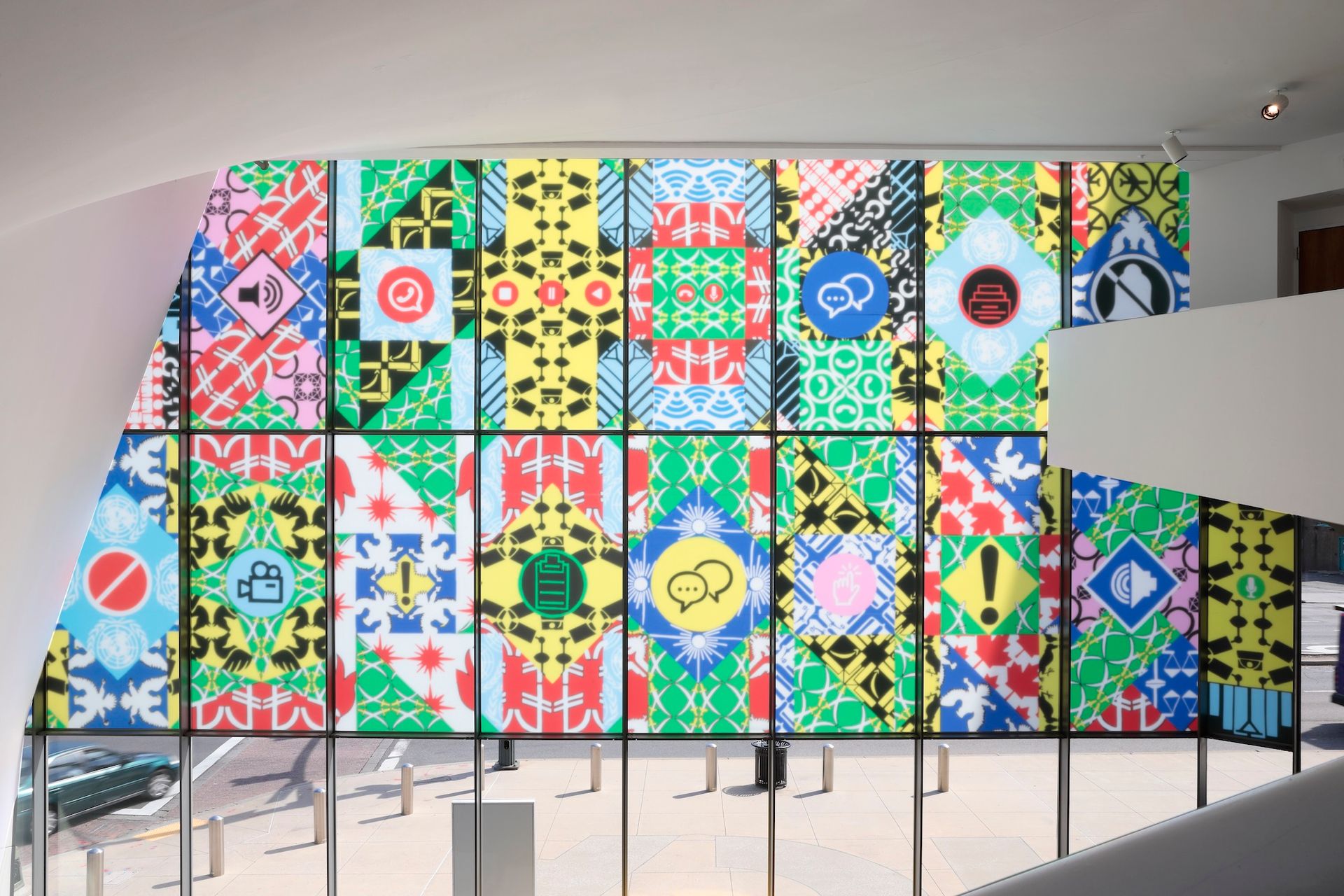When Jamal Khashoggi, the journalist who was critical of the Saudi government, was a contributing columnist with the Washington Post, he settled in the Virginia suburb of McLean. Now, more than four years after his brutal murder—which provoked outrage around the world—in the Saudi consulate in Istanbul, a large-scale public work reflecting on his life and career is on view in the state where he resided.
Commissioned by the Institute for Contemporary Art (ICA) at Virginia Commonwealth University, the work, McLean (2023), by Navine G. Dossos, covers a large section of the ICA’s panelled façade. It is composed of vinyl that showcases bold patterns and symbols arranged in a grid, evoking a zany quilt or tiled flooring. The symbols, ranging from a video camera to a diamond ring, allude to aspects of Khashoggi’s life.
“So much of the way that we think about this particular journalist is linked to the horrific circumstances of his death,” Dossos says, alluding to Khashoggi’s grisly ambush, strangling and dismemberment by a team of assassins. “For me, the work was not just about that—it was also about thinking about who he was as a person and the situation that has led us to become more aware of the vulnerability of journalists.”
McLean was unveiled four months after a US judge dismissed the case against Saudi Crown Prince Mohammed bin Salman, who is believed to have ordered Khashoggi’s murder. The journalist was visiting the Saudi consulate to obtain documents that would enable him to marry his fiancé, Hatice Cengiz, and never reappeared. While Mohammed bin Salman was implicated in a CIA report, the Saudi government has denied any connection to the murder.
Dossos, who is based in Greece, makes work informed by Islamic art and geometric abstraction that often engages with the digital realm. For the ICA’s façade, she reprised an earlier work that she had begun making in 2018 in response to Khashoggi’s death. She was living in Istanbul when news of his disappearance surfaced.
‘Systems of violence’
“It tapped into some of the stuff I’d been working on in Istanbul in terms of visibility of violence, and systems of violence in hidden spaces—be that domestic spaces or institutional spaces,” Dossos says.
She combed the news for articles related to Khashoggi, creating a painting each day in response to the narratives. The resulting work, No Such Organisation (2018-20), consists of 100 watercolour paintings featuring symbols related to surveillance technology and the main players in the case, laid out in a dynamic composition.

Navine G. Dossos, McLean, 2023, printed adhesive vinyl, variable. ICA
Commission. Photo by David Hale, Courtesy of The Institute for Contemporary Art at VCU
The ICA’s senior curator Sarah Rifky, who first met Dossos in 2011, says she wanted to find a way to “activate the building as a whole inside-out” when she arrived at the ICA in 2021. The first facade work she helped organise was by Luis Camnitzer, and she wanted to follow with “a work that both introduced a new artistic language to the city, and that also related to the politics of where we are,” she says. “Almost instantaneously when I reached out to Navine she suggested that we adapt the project No Such Organization that was commissioned by the Van Abbemuseum, and that was on the assassination and case of the journalist Jamal Khashoggi. The work was envisioned in a flash.”
McLean, which is on view until January 2024, adapts this work on a grand scale, functioning almost like a monument. Dossos made 100 gouache paintings measuring nearly a square metre each that were then translated into digital images and reproduced as UV-resistant vinyl. The motifs are suggestive but not didactic, and encourage curiosity and gradual engagement with the journalist’s life in a way that differs from the lure of a headline.
“We live in this mediatic loop where as soon as something is off the front page, it just disappears,” Dossos says. “We experience the drama, the horror and the terror, but we don’t necessarily hold that space, to see how it plays out back in the real world. My work is trying to reclaim that space—I want to make a space where we can deal with the subject, but not just repeat the violence.”
- Navine G. Dossos: McLean, until 7 January 2024, Institute for Contemporary Art at Virginia Commonwealth University, Richmond, Virginia


